
Introduction
While there are many special collections within the University of Western Ontario’s Archives and Special Collections, one of the most significant is the G. William Stuart Collection of Milton and Miltoniana. Purchased by Western in 1968, and supplemented in subsequent decades, it represents the greatest collection of its kind in Canada. The collection contains all of the early and many of the later editions of the works of John Milton, including two copies of the 1645 Poems, early and later editions of the major prose works, and over a hundred editions of Paradise Lost. Add to this a wide range of related seventeenth-century political and religious imprints, including numerous pamphlets. One such pamphlet is Joseph Hall’s Defence of the Remonstrance. First published in 1641, for the London stationer, Nathaniel Butter, it represents a reply within a longer polemical exchange known as the Smectymnus controversy, a debate that focused heavily on the issue of Church governance in England (Image 1). This polemical tone is made clear on the title page where we are told that “The right of Leiturgie and Episcopacie is clearly vindicated from the vaine cavils, and challenges of the ANSWERERS.” While Hall’s name is nowhere to be found on the title page, we are told that this Defence is “By the Author of the said Humble Remonstrance.” This point matters because it was this earlier work of Hall’s that prompted the counter-attacks, in print, from a pseudonymous group of Puritan divines known as Smectymnus, and eventually, from no less than John Milton himself.


[1] For more on Barnett, see Rebecca Power’s storymap: https://storymaps.arcgis.com/stories/4186fb416a1d495c90751aa8afecab6e |Back to section
Same, but Different: The Print Variants in Hall’s Remonstrance
Hall’s Defence of the Remonstrance is, like all printed works of the era, a product of human, tactile labour, and as a result, a work that contains errors. When printing a sheet for a run of say 700 copies, the printer or the compositors working for him or her,[2] might only notice an error after several hundred sheets are printed. Rather than dispose of the sheets, the printer would often keep them, but reset the type before printing the remainder of the run. Those cases where an error is caught and corrected during the printing of the work are known as stop-press corrections. Hall’s Defence of the Remonstrance shows evidence of this kind of correction as some surviving copies have the correct spelling of “having,” on Q3r, while the others survive with it misspelled. In the case of Western’s three copies, one of them is in the corrected state (Image 3), while the other two are in the uncorrected state (Image 4). As seen in the images shown here, reader-annotators have made corrections to the print with handwritten corrections in the uncorrected copies.[3]


That both of the uncorrected copies show evidence of a similar ms. correction may seem surprising at first, but not when we consider that printers guided readers to emend. Typically located near the end of a work is what is known as an Errata, that is a list of printed errors found within the work. The inclusion of a printed Errata in early imprints was common. On the one hand it served as an admission of error, and so a publishing of the printer’s mistakes, but it also acknowledged that the errors had been caught, and so a reminder of the printer’s careful review of the work. Even when certain errors were caught and corrected, however, new ones might emerge or be discovered after yet another printing. For example, while copy one has the correct “having” on an early page, it also has the incorrect “about” on a later page (Image 5). As the Errata at the end of this copy notes, p. 135, line 11 should read “without” and so directs the reader to the original error and correction (Image 6).
While this truncated discussion offers but a brief insight into one aspect of the early modern printing process, it does highlight the differences that exist between copies, even during the printing stage. While it is true that Western owns three copies of Hall’s Defence of the Remonstrance, each of those copies contain textual variants and so are not the same.[4]

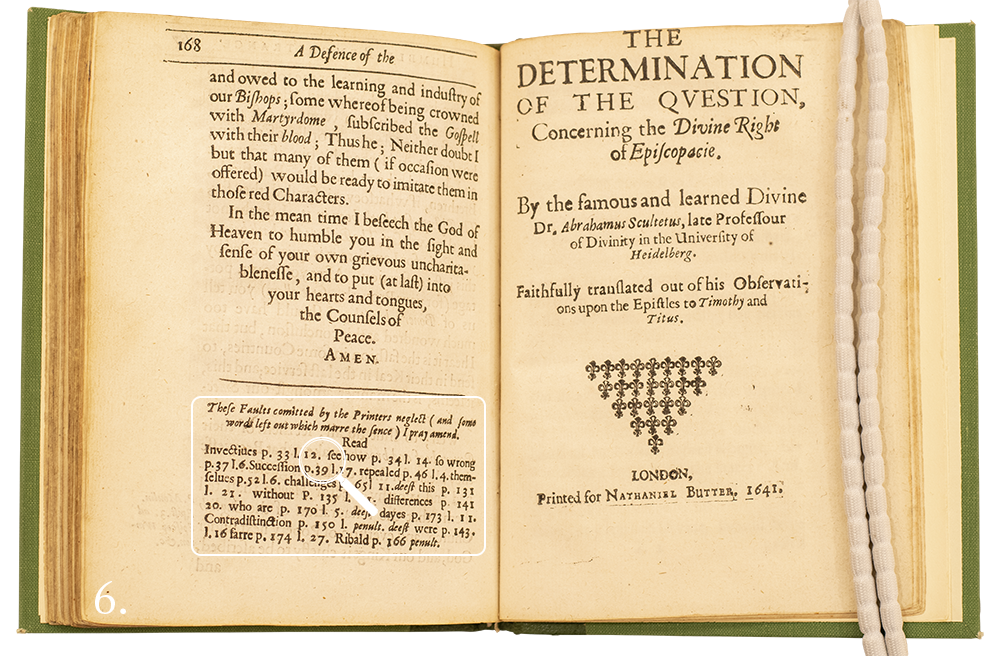
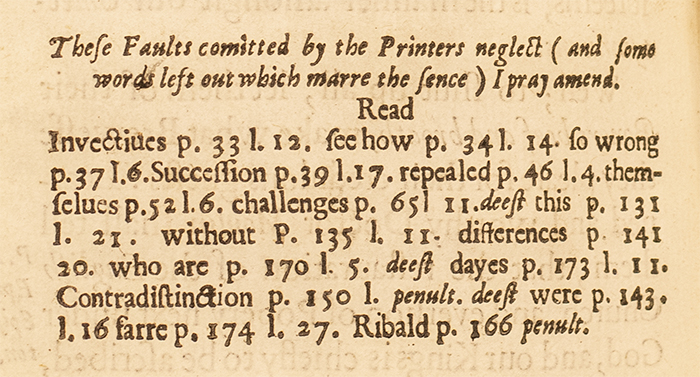
[2] For more on the importance of women stationers in the booktrade in this period, see the rich collection of chapters in Valerie Wayne (ed), Women’s Labor and the History of the Book in Early Modern England (London: Arden, 2020). |Back to section
[3] These three ESTC records: http://estc.bl.uk/R188181, http://estc.bl.uk/R9524, and http://estc.bl.uk/R228131 offers a good starting point for identifying differences in this work. Having said that, my investigation would suggest that the issues and states might be even more complex than those listed on ESTC. |Back to section
[4] The presence of printed errors and the various approaches to correcting them has been a commonplace in Western printing since its origins. For a fascinating discussion of a particular set of errors in The Gutenberg Bible, see Paul Needham, “Copy-Specifics in the Printing Shop” (pp. 9-20 of Bettina Wagner’s Early Printed Books as Material Objects, vol. 149, Walter de Gruyter 2010). |Back to section

Provenance Matters
Such variance between these three copies only multiplies as we look beyond the imprint to the bindings and marks of ownership. The first copy, shown here (image 7), is rebound in a twentieth-century binding of half dark green goatskin over light green cloth boards with the title expertly gold-tooled across the spine (Image 8). Copies in pristine bindings such as these were common in later collectors’ private libraries. While we may celebrate such artistry, such taste often comes with a cost, since rebinding often resulted in the removal of important textual evidence. Not only is the old binding typically removed and disposed during the rebinding process, but so too are the endpapers and other binding structures. Add to this that in some cases, books that had been previously bound together are broken up by later booksellers and/or owners. The material loss in these cases is best described as a form of erasure. In some cases, we can recover aspects of the previous binding structure through careful examination of the sewing holes left in the gutters of books. Similarly, the use of CT scans has helped to see earlier binding structures and the presence of missing leaves in both early print and manuscript. In many cases, however, the material evidence is simply irrecoverable.[5]

These previous points become clearer when we turn to the second copy. Unlike the first example, this copy is bound in near-contemporary, blind-tooled calf with a later printed label added to the spine. It is likely that the initials “H.R.” on the fore-edge, shown here (Image 9), stands for Hall’s Remonstrance. These easily ignored ink letters remind us that books were still regularly shelved fore-edge out in the seventeenth century and that the use of spine labels was still in development.
As we open copy two, we are met with a short inscription in an early hand on the liturgy of the Church (Image 10).
This inscription could serve various purposes. It might be excerpted and placed here for quick reference. It might also serve as support for English Church practice and thus function as a gesture in favour of the work that follows. While we can only speculate on the purpose of this inscription, it does remind us of the value of blank spaces for early owners and readers. In fact, the endpapers in early books, much like the margins of such works (Image 11), form a treasure trove for understanding everything from reading practices to how books were acquired and exchanged.
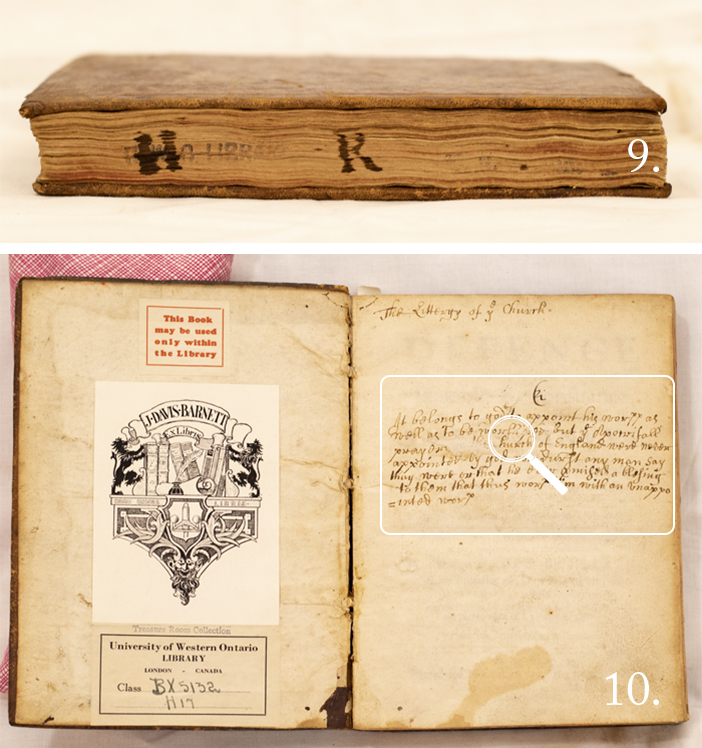
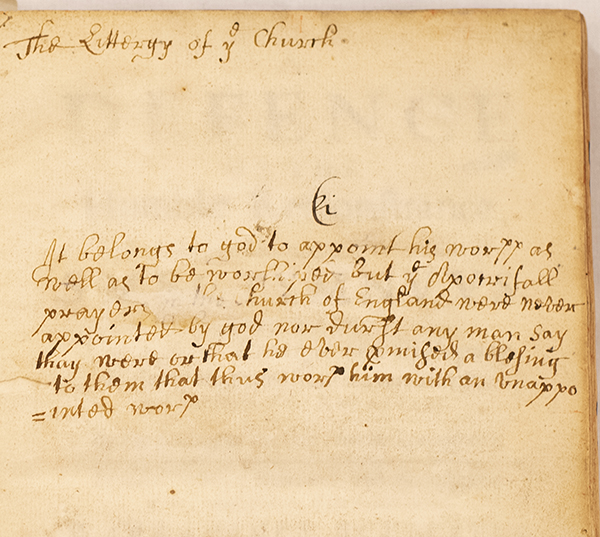
As mentioned above, copy 2 is one of the copies bound with another work. In this case, the second imprint is An Answer to a book entitled A Humble Remonstrance (WING M748), one of the contributions of the collective known as Smectymnus (Image 12). Smectymnus is typically read as both pseudonym and cipher for the authors who challenged Hall and is often deciphered by turning to the letters sequentially to point to the first and last names of the contributors. In surviving copies, it is common to see the pseudonym deciphered in ink as seen here (Image 12, magnifying glass icon).

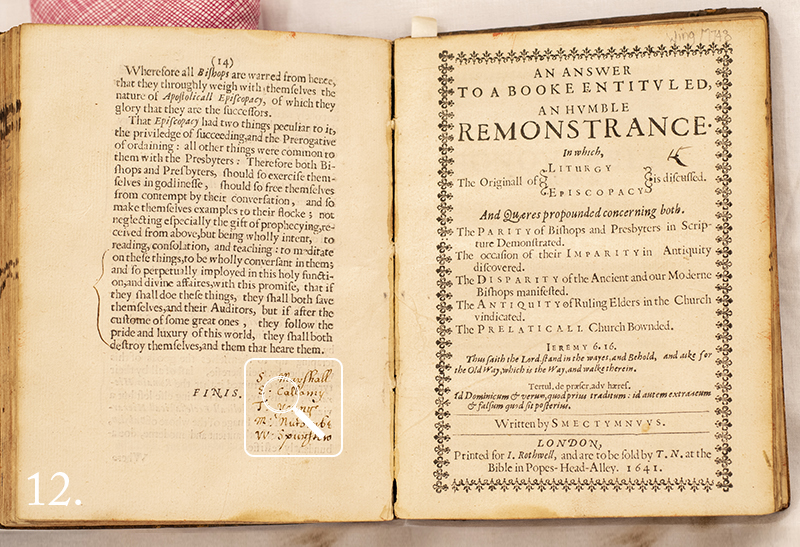
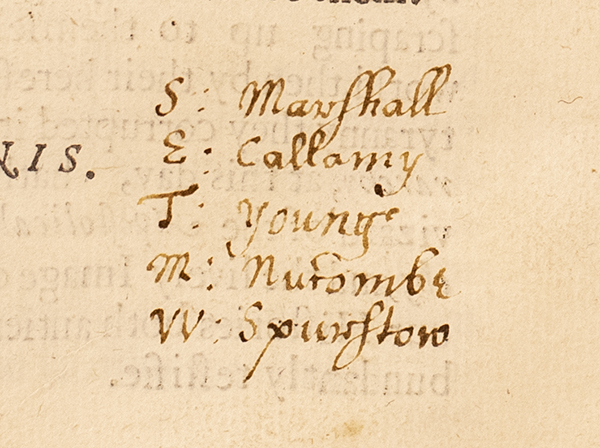

The third copy is similar to the second in that it is also bound in blind-tooled calf, but this time it is speckled.[6] What makes this copy unique, however, is that it contains eight imprints from the Smectymnus controversy, including multiple contributions by Milton (Images 13 and 14). Joseph Hall’s Defence of the Remonstrance appears third in the sammlebande. In addition, there are multiple marks of ownership that point to the work’s Welsh provenance. The bookplate on the inner pastedown of Watkin Williams Esq. of Penbedw in the County of Denbeigh covers an earlier bookplate from the Mostyn family (Image 15).
This second bookplate is barely detectable through a magnify glass, but the Mostyn name can be seen. This second bookplate proves important since the copy also contains an early inscription that reads RMostyn Christ Church Oxon (below, Image 16). While there were many Mostyns with the name Roger and Richard from the sixteenth century onward, the likely candidate is Richard Mostyn (1658-1735). Since he matriculated at Christ Church, Oxford and received his BA in 1674 and his MA in 1680, this would place the inscription as c.1674-1680. But there is more. As David Pearson’s BookOwners Online notes, books with Roger Mostyn’s armorial bookplate are sometimes covered by the bookplate of Watkin Williams, who inherited them.[7]
What we have then is a line of Welsh provenance that begins in the seventeenth century and continues through to the late eighteenth/early nineteenth century.
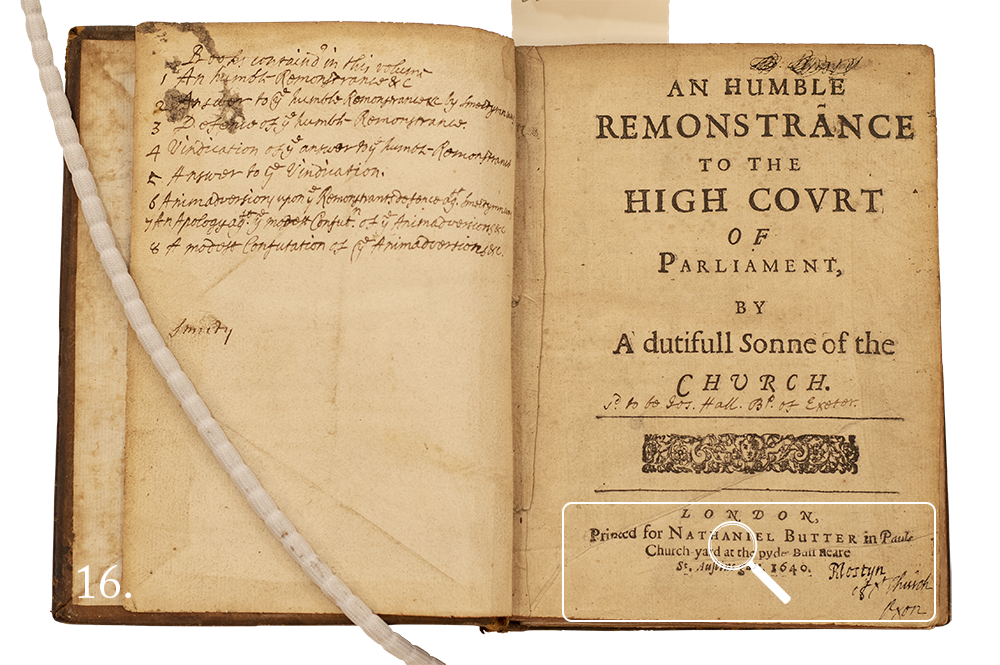
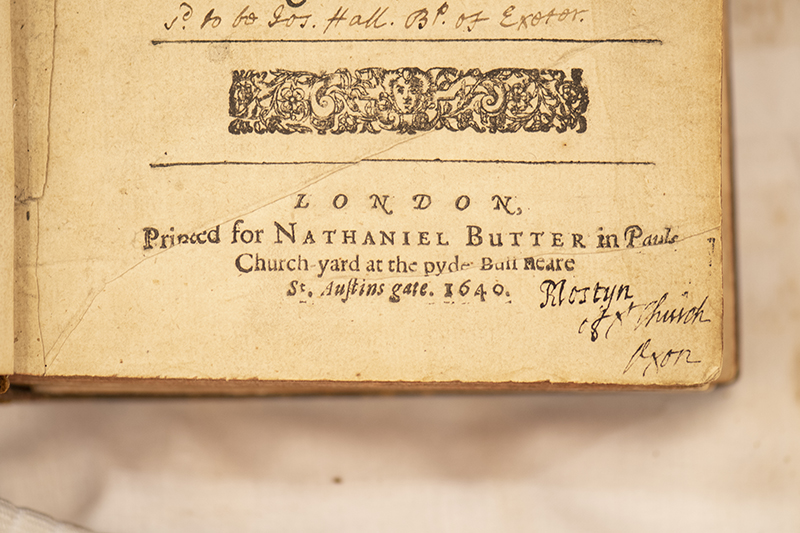
[5] For more on the presence of stab-stitching in early English imprints and its use for reimagining binding structures, see Aaron Pratt, “Stab-Stitching and the Status of Early English Playbooks as Literature” The Library 16.3 (September, 2015) 304-324. For recent experiments with CT scanning on early manuscripts, including examples from Western, see the examples discussed from the Old Books, New Science Project: https://www.youtube.com/watch?v=98xZnBrJwvQ and https://youtu.be/Gsm7L6tuSZs |Back to section
[6] For more on the dating and styles of Early English Bookbindings, see English Bookbinding Styles 1450-1800 and Trade Bookbinding in the British Isles 1660-1800 |Back to section
[7] The inscription at the foot of the title page seems to be in two different hands. It is as if “Church Oxon” was added at a later date. |Back to section
Reflecting on Multiple Copies and why they Matter
Some years ago, as I was preparing material for a new course I was co-teaching with John Vanderheide[8] on adaptation, I turned to another of Western’s special collections, the William R. Poole T.S. Eliot collection. I was interested in early editions of The Waste Land, and after looking at the poem in The Criterion and The Dial, the two earliest periodical printings of the poem, I found myself with various early editions, including one published by Leonard and Virginia Woolf for the Hogarth Press in 1923. Before wrapping up my examination of these treasures, I turned to two first editions of Eliot’s Poems 1909-1925 to see how The Waste Land had been anthologized in this 1925 collection (Image 17). As was the case with the multiple copies I have just discussed, the two copies of Eliot’s Poems were also distinct. While both are bound in the same blue publisher’s cloth, only one (copy 1) contained the original wrapper (Image 18).


And while the second (copy 2) may not have had the wrapper, it did have an early provenance “Norman Endicott 1927,” and a typed fragment of the final lines of Eliot’s famous Love Song of Sir J. Alfred Prufrock (Image 19).[9] Of greatest interest, however, were the poems in copy 1, for they had been annotated in pencil in a small tight hand. This copy had been owned by William Edwin Collin, Professor of Romance Languages at the University of Western Ontario from 1923-1959 (Image 20). While I was unsure if these annotations were in Collin’s hand, a quick search online suggested a high probability and an examination of other manuscript notes in Collin’s hand offered a match.[10] In 1936, Collin’s The White Savannahs (Toronto: MacMillan, 1936) was published, a work that used a modernist lens to study nine Canadian poets, including a number who were still largely unknown. One of the writers Collin’s turned to for this modernist approach was T.S. Eliot.[11]
While one can only speculate as to the precise relationship between the annotations in Collin’s copy and his later study of 1936, one thing is for certain: the annotations show an engaged and active reader of Eliot who is keen to track allusions, be they to the Bible, Baudelaire, Valery or Shakespeare, and equally keen to archive important early reviews by I.A. Richards, Edwin Muir, and others. The value of a copy like this is significant (Image 21). The annotations offer us access to the reading practices of an early twentieth-century Professor, an academic who was looking to Eliot in his researching of what would become a landmark in early twentieth-century criticism of Canadian poetry. Those annotations also provide a possible case study in the early reception of Eliot outside of the US and Britain. While I am unable to place an exact date on the annotations, most of the citations are to works of c. 1925-1930, and so the marginalia are also possibly early.[12] Finally, this copy is not part of the William R. Poole T.S. Eliot collection, and so offers a reminder of the value of examining those second or third copies living outside of specialized sub-collections. Indeed, while writing this post, Western acquired another copy of the Poems 1909-1925, but this time of the second edition. While it is not annotated, it does contain Eliot’s signature, a date of 1935, and a dedication “Inscribed for William D. Hennessy Jr.” (Image 22).

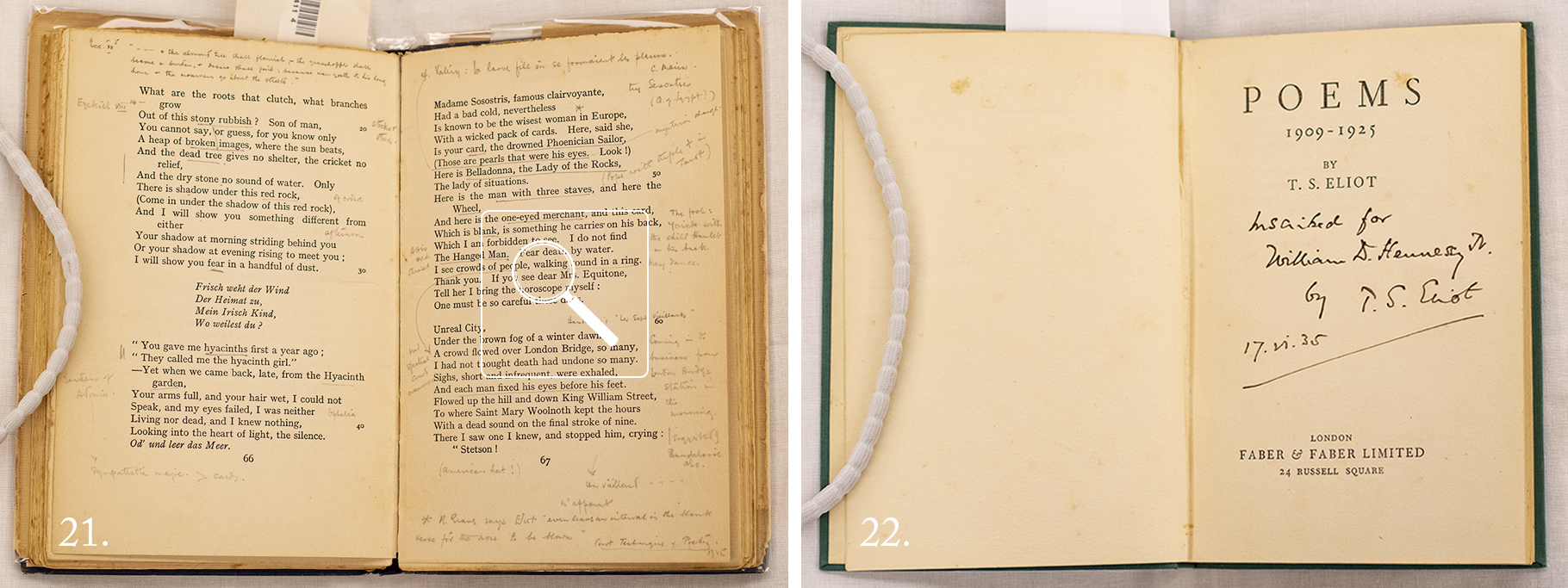
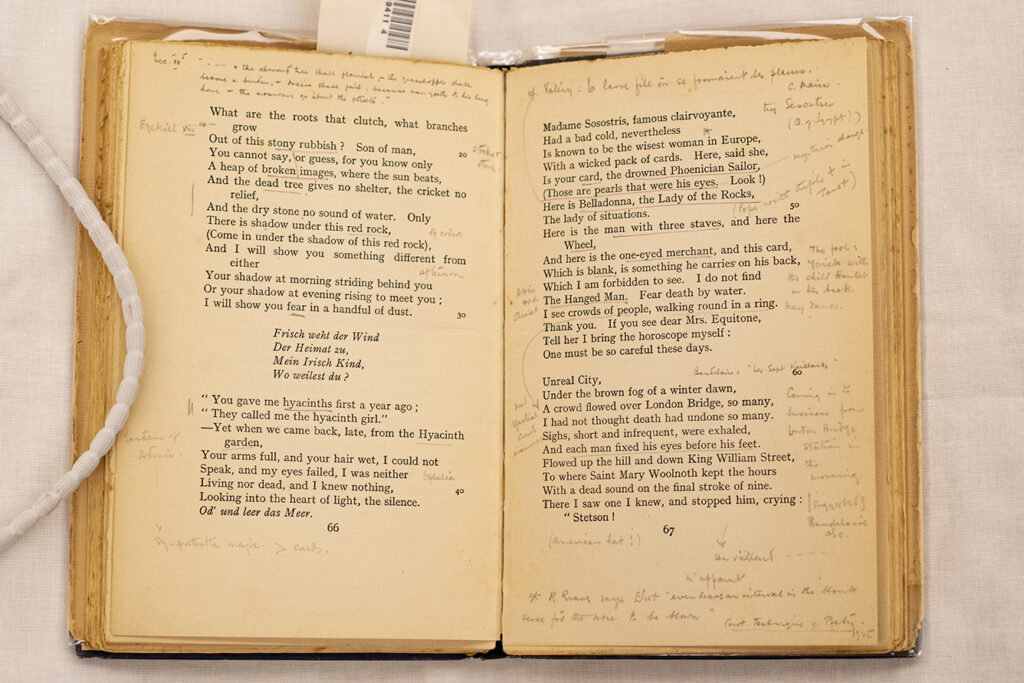
Once again, and as we have seen throughout this post, such material features, be they in seventeenth-century or twentieth-century copies, offer more than a string of curious findings. They remind us of the need to preserve individual copies. A single inscription, bookplate or annotation may contain the key to better understanding a literary network, or it may offer new insights into a writer’s research methods. At the very least, such traces remind us of the human connection to books.
[8] “Forms of Adaptation: A Critical Making Course” is now in its 4th iteration. For this year’s offering, see the syllabus here. |Back to section
[9] Much of Norman Endicott’s Library is held at the University of Toronto in the Thomas Fisher Rare Book Library. |Back to section
[10] I am grateful to Theresa Regnier at Western Libraries Archives and Special Collections for alerting me to the Collin fonds and for providing access to manuscripts in his hand. |Back to section
[11] For an overview of Collin’s life and works with a particular focus on his literary criticism, see Germaine Warkentin’s Introduction to Collin’s The White Savannahs: The First Study of Canadian Poetry from a Contemporary Viewpoint (Macmillan, 1975). |Back to section
[12] A survey of the annotations show the latest dated citation as 1932. |Back to section